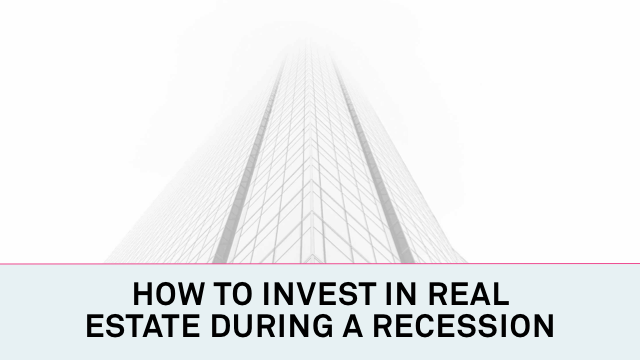Table of Contents
The business and financial worlds are increasingly dominated by talk about a looming recession. It seems that everyone expects a market correction to occur sometime within the next six to twelve months. The timing and importance of that correction is anyone’s guess.
There’s a difference between a market correction, where values dip 10% from their most recent peak, and a true recession. To be considered a true recession, values will need to plummet 20% or more.
Is a real estate recession really on the horizon? Deciphering the difference between reality and hype created for headlines can be difficult. In this article, we examine 3 signs that a real estate recession could be coming. We also look at strategies to prepare your portfolio to withstand the impact if and when it inevitably does.
What’re 3 Signs a Real Estate Recession is Coming?
Often times each individual recession has some of its own unique features associated with it . For example, overvalued tech stocks leading up to the Dot Com bust or the real estate debt bubble that preceded the 2008 to 2010 housing market crash). There tend to be a few key phenomena associated with nearly all of the recessions that have occurred since the Great Depression.
- Private-sector Economics Survey
by The Wall Street Journal - Survey of the Economists, Real Estate Market Analaysis
by Pulsenomics
1. Flattening of the yield curve
When economists refer to the “yield curve,” they’re referring to the delta between the interest rates paid on short term vs. long term Treasury bonds. This delta is indicative of bond investors’ feelings about risk. Typically, long term bonds pay higher interest rates than short term bonds. The yield curve is said to be flattening when this delta narrows. Sometimes an inversion will occur where the short term rates are higher than the long term rates. This signals investors’ fears about the future. Because of this there is more interest in short term bonds than long term.
The “yield curve” refers to the delta between the interest rates paid on short-term vs. long-term Treasury bonds.
According to the Federal Reserve Bank of San Francisco, the yield curve has inverted before each recession since 1955. A recession followed between six and 24 months later
Depending on how you splice the data, there’s a dramatic flattening of the yield curve today. How stark this difference is depends on which bond terms analysts use. Those who compare 2 year bonds to 10 year bonds will see the curve flattening. The spread was up to 159 basis points in April 2021 and down to just 18 basis points at the end of May.
In late March, the spread between the 5 year and 30 year Treasury yields inverted for the first time since February 2006.
Is It Time to Panic?
Not necessarily. Another closely monitored part of the yield curve has been the spread on three month treasury bills and 10 year notes. These started widening in March and only began to dip again in recent weeks.
Real estate investors will still want to monitor the flattening of the yield curve closely. This is because banks borrow at short term lending rates and then lend at long term rates. As this spread narrows, some banks will curtail their lending. This threatens to bring real estate activity to a halt.
2. Skyrocketing oil prices
Another sign that a recession may be on the horizon is that the cost of oil is increasing. The past three U.S. recessions were all preceded by a sharp uptick in oil prices. This happened in 1990, again in 1999-2000, and in late 2007 to early 2008. A sharp rise in oil prices can have a massive effect on economic activity. This is because it represents such a large expense for many enterprises.
Oil is a key cost for many businesses, so a
dramatic increase in the price of oil
can have a major impact on economic activity.
According to Nicholas Colas, co-founder of DataTrek Research, “the magic number is 90%. When oil prices go up 90% over a 10 to 12 month period, the U.S. has a recession.” In each of the periods referenced above, oil prices rose at least 90% or more and sure enough, a recession followed suit.
In March, crude oil prices hit a staggering $139/barrel amid concerns over Russia’s invasion of Ukraine. This is the highest price it’s risen to since 2008. Oil continues to hover around $115/barrel today, with most Americans paying at least $4/gallon each time they visit the pump.
3. Slump in home sales
Declining home sales are another sign that a recession may be looming. Prior to each of the last three recessions, there was a marked slowdown in the pace of single family sales.
Single family home sales are used as a barometer of economic activity compared to other housing indicators, explains Federal Reserve Bank economist William Emmons. This is because they are indicative of household decision making unlike housing metrics influenced by national trends and policies.
Recently released data indicates that purchases of new single family homes dropped a staggering 16.6% in April. This brought home sales to the lowest level since April 2020 when Covid brought the economy to a halt. Economists had only been predicting a marginal 1.7% decline in sales, so this news may potentially rattle the market.
How do I Prepare Your Real Estate Portfolio Ahead of a Recession?
Real estate recessions are like rainstorms: one is always coming. It’s just a matter of when and how severe it will be. The best thing for real estate investors to do is to prepare their portfolio now for when that time comes.
There are a few specific strategies real estate investors can consider that will help to recession proof their portfolios.
Evaluate the amount and types of debt
It’s common for people to talk about the loan-to-value ratio on any given property. However, the LTV on one property generally matters less than the LTV on an entire portfolio. When a property owner has a high level of debt on one property, they may be considered over levered. If they have minimal debt on their other assets, it can balance out the high leverage on one property. High debt on one property shouldn’t drag the rest of the portfolio down.
Now is also a good time to lock in low cost, fixed rate debt ahead of future interest rate hikes. The Federal Reserve Bank has been slowly raising rates and is expected to continue doing so throughout the year to combat growing inflation.
Carefully consider asset type
Covid is a great reminder that some asset classes outperform others during periods of economic upheaval. The pandemic impacted office, retail and hospitality properties more significantly than multifamily or industrial.

When recessions occur, there is often a heightened demand for multifamily housing. This is due to people being forced to sell their homes or make some other dramatic change to their living situation. Often, they have no choice but to move into an apartment building for some time.
Others may put home buying on hold entirely, opting to rent until economic conditions improve.
Build up cash reserves
It is always important to maintain strong cash reserves. This is especially true heading into a recession. Cash reserves are critical for combating late/non payment of rent situations, banks’ more stringent lending procedures, and escalating operational and capital costs. Having strong cash reserves is the best way to protect yourself from the unknowns associated with any market downturn.
Of course, there are many ways to bolster reserves. Bolstering reserves can be done through some combination of increasing revenue and decreasing operational costs.
An overlooked strategy is to simply gain spending visibility. Owners should comb through their expenses to understand how, where, when and why certain funds are being spent. Owners can categorize costs as either strategic or non strategic. Then, they can decide whether to curtail non strategic costs ahead of any anticipated recession.
Conclusion
Although nobody can predict with any certainty when the next recession will hit, there are some indicators that one may be on the horizon. To be sure, this is not a time to panic. On the contrary, a recession can be a great time to invest in real estate. This may not give comfort to those who own real estate already, but in our experience, there are steps owners can take to protect their portfolio in the event of a downturn.
At Smartland, we always strive to protect our assets and maximize value regardless of where we are in the real estate market cycle. To learn more about our specific approaches, contact us today!
FAQs
What’s the difference between a correction and a real estate recession?
A correction is a drop of about 10% from a recent peak. A true recession involves a deeper decline of roughly 20% or more.
What early signs should I watch?
Three big ones: a flattening or inversion of the Treasury yield curve, a sharp run up in oil prices, and a slump in single family home sales. These patterns have shown up ahead of past downturns.
Why does the yield curve matter for real estate?
Banks borrow at short term rates and lend at long term rates. When that spread narrows, some lenders pull back, which can slow transactions and development.
Do oil spikes really precede recessions?
Often. The past three U.S. recessions were preceded by sharp oil price increases. As a rule of thumb, a ~90% rise over 10-12 months has lined up with recessions historically.
How can I get my portfolio ready?
Review debt across the whole portfolio, favor fixed-rate where it fits, and build cash reserves. Consider defensive asset types like multifamily, which have held up better in past disruptions. Tighten expenses and improve visibility before conditions worsen.
Should I panic or sit tight?
Neither. No one can time the next recession, but you can prepare. Downturns can also open opportunities for disciplined investors who come in with strong reserves and a clear plan.


